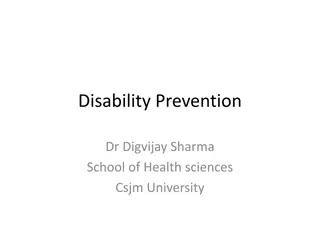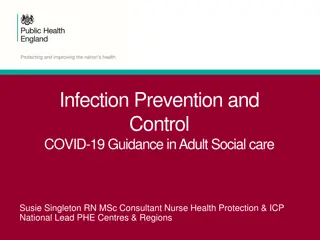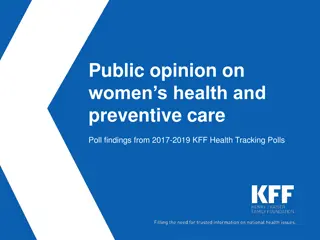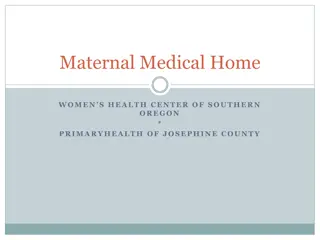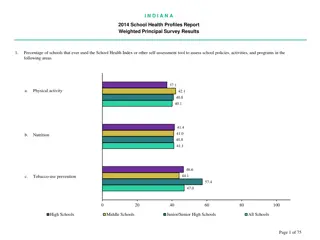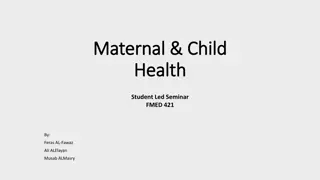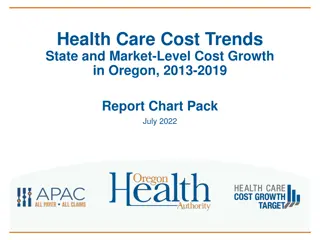Understanding Women's Health: Risks, Prevention, and Care
Women's health encompasses the screening, diagnosis, and management of diseases and conditions affecting physical and emotional well-being. Services are provided by a diverse team of healthcare professionals specializing in obstetrics, gynecology, surgery, and primary care. Cardiovascular disease is a leading concern for women, with risk factors including age, family history, hypertension, and unique factors like menarche and menopause. Pregnancy complications can also impact cardiovascular health. Aspirin use may be beneficial for CVD prevention in certain age groups. Regular screening, such as for dyslipidemia, is important for maintaining women's health.
Download Presentation

Please find below an Image/Link to download the presentation.
The content on the website is provided AS IS for your information and personal use only. It may not be sold, licensed, or shared on other websites without obtaining consent from the author. Download presentation by click this link. If you encounter any issues during the download, it is possible that the publisher has removed the file from their server.
E N D
Presentation Transcript
Definition Women's health refers to the branch of medicine that focuses on screening , diagnosis and management of diseases and conditions that affect a woman's physical and emotional well-being. It is important to : Preservation of wellness Prevention of illness
Who provides woman health The women's health services team includes doctors and health care providers from a variety of different specialties. include: Obstetrician/gynecologist General surgeons specializing in breast care Perinatologist Primary care doctor
CVD in Women Cardiovascular disease (CVD) is the leading cause of death in women. The incidence of myocardial infarction (MI) in women, although lower than in men, increases dramatically following menopause.
CVD in Women Risk factors in common with men: Age Family history. Hypertension. Lipids and lipoproteins. Diabetes mellitus. Lifestyle factors.
CVD in Women Risk factors unique to women: Menarche: Early menarche appears to be associated with future CVD risk. Menopause: Postmenopausal state as a risk factor for CVD Hysterectomy. Premenstrual syndrome: Variety of physical and emotional symptoms and typically occurs in the days prior to the onset of menses Oral contraceptives
CVD in Women Pregnancy complications: Hypertension and diabetes that develop during pregnancy. Spontaneous pregnancy loss. Preterm birth.
Incidence of myocardial infarction in men and women
CVD in Women Use of Aspirin in prevention of CVD: In women age 55-79 years old, 75 mg of Aspirin per day for at least 10 years for primary prevention decreases the risk of myocardial infarction (MI) and possibly all-cause mortality.
Screening Dyslipidemia: Patients aged 17 to 21 years suggested to undergo one-time screening for hyperlipidemia: High risk patients: screening starts at age 25 for men and 35 for women Not at high risk: screening starts at age age 35 for men and 45 for women..
When a decision is made to screen lipids we suggest measuring: Total Cholesterol. High Density Lipoprotein Cholesterol
Screening Diabetes Mellitus: Screening tests include Hg-A1C level, fasting plasma glucose level, and two-hour 75-g oral glucose tolerance test.
Screening criteria of DM All adults beginning at 45 years of age. Adults with BMI 25 plus one of the following risk factors: Physical inactivity . 1st degree relative with DMT2. Hypertension. HDL < 35 mg/dLor TAG > 150 mg/dL. Polycystic ovarian syndrome
Screening Hypertension: Screen for elevated blood pressure (greater than 140/90 mm Hg) in all adults 18 years and older.
Cervical Cancer Cervical cancer used to be the leading cause of cancer death. Cervical cancer is the third most common cancer in the world. Cervical cancer is highly preventable because screening tests and a vaccine to prevent human papillomavirus (HPV) infections are available.
Risk Factors for Cervical Cancer Almost all cervical cancers are caused by human papillomavirus (HPV). Other things can increase your risk of cervical cancer -Smoking. - Having given birth to three or more children. - Having several sexual partners.
Cervical Cancer: Diagnosis and Treatment Early detection: Pap test. Tests to confirm a diagnosis of cervical cancer include: -A colposcopy and cervical biopsy. -An endocervicalbiopsy (or curettage). Treatment Surgery Chemotherapy Radiation
Breast cancer Breast cancer is a group of diseases that affects breast tissue. Both women and men can get breast cancer, though it is much more common in women. Breast cancer is the most common cancer among women in the United States. Breast cancer is the second leading cause of cancer deaths among women in the United States. Getting mammograms regularly can lower the risk of dying from breast cancer.
Kinds of Breast Cancer The most common kinds of breast cancer are :- - Invasive ductal carcinoma. - Invasive lobular carcinoma. There are several other less common kinds of breast cancer, such as Paget s disease, medullary, mucinous, and inflammatory breast cancer.
Symptoms of Breast Cancer New lump in the breast or underarm (armpit). Thickening or swelling of part of the breast. Irritation or dimpling of breast skin. Redness or flaky skin in the nipple area or the breast. Pulling in of the nipple or pain in the nipple area. Nipple discharge other than breast milk, including blood. Any change in the size or the shape of the breast. Pain in any area of the breast.
Diagnosis of Breast Cancer Breast ultrasound. Diagnostic mammogram. Magnetic resonance imaging (MRI) Biopsy.
Treatment of Breast Cancer Surgery. Chemotherapy. Hormonal therapy. Radiation therapy.
Planning for pregnancy Make a Plan and Take Action See Her Doctor Medical Conditions Lifestyle and Behaviors Medications Vaccinations
Take 400 Micrograms of Folic Acid Every Day Stop Drinking Alcohol, Smoking, and Using Street Drugs Avoid Toxic Substances and Environmental Contaminants Reach and Maintain a Healthy Weight Get Mentally Healthy
contraceptive Do you want to be pregnant in the future? If yes, whendo you want to bepregnant? Women who desire pregnancy within one year we provide information about reversible contraceptives Women who do not desire pregnancy within one year For women who desire long-term contraception, we provide information on reversible and permanent contraceptive options
STIs among women The effect of STIs on women can be more serious than men. Untreated STIs can cause infertility, pelvic inflammatory diseases, pre-term delivery, and fetal/neonatal pathologies, ectopic pregnancy, increased risk of HIV transmission or worst cervical cancer.
Sexually transmitted infection High risk group: Sexually active adults, with multiple partners who have an STI or have had one within the past year Causative organisms: chlamydia, gonorrhea, syphilis, HIV
Criteria of screening All sexually active women 24 years and younger should be screened annually for chlamydia. High-risk women should be screened at least annually for chlamydia, gonorrhea, and syphilis. All adolescents should be screened and adults through 65 years of age for HIV
HOW CAN STIs AFFECT THE MOTHER AND HER FETUS ? She may pass the infection to her baby before, during, or after the baby s birth. She could go into labor too early. This makes it more likely that her baby will be born weighing less than 5 pounds, which is less than a healthy newborn baby should weigh.
A doctor might decide to do a cesarean delivery (C-section) to protect her baby from infection. The infection may cause serious health problems in her baby.
Osteoporosis Screening for osteoporosis involves fracture risk assessment and measurement of bone mineral density We recommend assessing risk factors for fracture in all adults, especially postmenopausal women.
Test of screening : Dual-energy x-ray absorptiometry DXA is the most widely used method for measuring BMD Criteria of screening: in all women 65 years of age and older in postmenopausal women less than 65 years if one or more risk factors are present . ( next slide ) We suggest not performing routine BMD measurements in premenopausal women. Postmenopausal women with fracture
Risk factors Validated risk factors that are independent of BMD include the following: Advanced age Previous fracture Long-term glucocorticoid therapy Low body weight (less than 58 kg [127 lb]) Family history of hip fracture Cigarette smoking Excess alcohol intake
Site of screening: DXA of hip and spine. Repeat of screening: - In women 65 years of age and older with normal or slightly low bone mass with no risk factor (follow-up DXA in 10 to 15 years). - In women 65 years of age and older with low bone mass at any site, and with no risk ( follow-up DXA in three to five years )
immunization maternal immunization protects both the mother and fetus from the morbidity of certain infections Ideally, women should be vaccinated against preventable diseases in their environment prior to conception according to the recommended adult immunization schedule
Immunizations that may be administered before, during, and after pregnancy
general guidelines for immunization of pregnant women: immunizations routinely recommended for all pregnant women: tetanus, diphtheria, pertussis, and influenza. Following delivery, postpartum women should receive all recommended vaccines that could not be or were not administered during pregnancy (eg, measles, mumps, and rubella; varicella; tetanus toxoid, diphtheria, and acellular pertussis ). Providers should be aware of and follow contraindications and precautions for immunization of pregnant women (eg, avoid administration of live attenuated virus vaccines).
Two types of vaccines Routine Vaccines : Hepatitis A, Hepatitis B ,Human Papillomavirus (HPV), Influenza (inactivated) , Influenza (LAIV), Measles, Mumps, Rubella (MMR), Meningococcal, Meningococcal (MenB),Pneumococcal Conjugate (PCV13), Pneumococcal Polysaccharide (PPSV23) ,Polio (IPV) , Tetanus, Diphtheria, and Pertussis (Tdap); & Tetanus and Diphtheria (Td) ,Varicella , Zoster Travel and Other: Anthrax , BCG , Japanese Encephalitis , Rabies , Typhoid , Vaccinia(Smallpox) , Yellow Fever
Which of the following factors increases the risk of breast cancer among women? a. Obesity and nulliparity* b. Age at menarche c. Multiple pregnancies d. Low-fiber diet
Which one of the following is Criteria of screening Osteoporosis? A-Women younger than 65 year old with one or more risk factor of osteoporosis* B-All women below 65 year old C-Postmenopausal women without fracture
reference https://www.cdc.gov/std/herpes/the-facts/default.htm https://www.cdc.gov/std/chlamydia/the-facts/default.htm https://www.cdc.gov/std/syphilis/the-facts/default.htm https://www.cdc.gov/std/pregnancy/the-facts/default.htm https://www.cdc.gov/preconception/planning.html https://www.cdc.gov/ncbddd/fasd/alcohol-use.html https://www.cdc.gov/features/pregnantdontsmoke/index.html https://www.uptodate.com/contents/screening-for- osteoporosis?source=search_result&search=screening%20osteoporosis%20in%20women&se lectedTitle=1~150#H20 https://www.uptodate.com/contents/immunizations-during- pregnancy?source=search_result&search=Recommended%20immunizations%20for%20wom en.&selectedTitle=1~150
Thank You Done by: Mohammad AlGhofili Ibrahim AlRabiah Mohammad AlBaz







